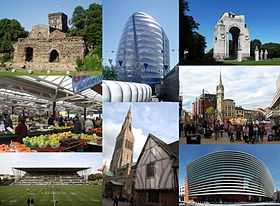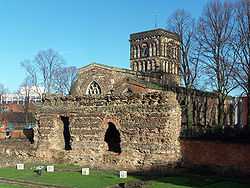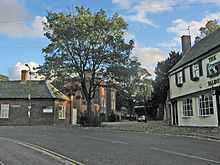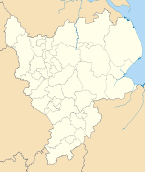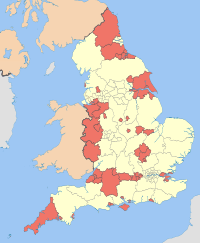Leicester
Coordinates: 52°38′N 1°8′W / 52.633°N 1.133°W
| Leicester City of Leicester | ||
|---|---|---|
| City & unitary authority area | ||
|
Leicester landmarks: (clockwise from top-left) Jewry Wall, National Space Centre, Leicester War Memorial, Central Leicester, Curve theatre, Leicester Cathedral and Guildhall, Welford Road Stadium, Leicester Market | ||
| ||
| Motto: Semper Eadem (Always the Same) | ||
 Location within Leicestershire and England | ||
| Coordinates: 52°38′N 1°08′W / 52.633°N 1.133°W | ||
| Sovereign state |
| |
| Constituent country | England | |
| Region | East Midlands | |
| Ceremonial county | Leicestershire | |
| Admin HQ |
City Hall 115 Charles St Leicester LE1 1FZ | |
| Founded |
AD 50 as Ratae Corieltauvorum by the Romans | |
| City Status | restored 1919 | |
| Government | ||
| • Type | Unitary authority, City | |
| • Lord Mayor | John Thomas | |
| • City Mayor | Peter Soulsby | |
| • Leadership | Elected mayor and cabinet | |
| • Unitary authority | Leicester City Council | |
| • List of MPs |
List of MPs
| |
| Area | ||
| • City & unitary authority area | 73.32 km2 (28.31 sq mi) | |
| Population (2011 est.) | ||
| • City & unitary authority area | 329,600 (Ranked 17th) | |
| • Density | 4,180/km2 (10,800/sq mi) | |
| • Urban | 509,000 | |
| • Metro | 836,484[1] | |
| • Ethnicity (2011 statistics)[2] |
White Groups (50.6%) Asian (35.8%) Black (6.3%) Mixed (3.5%) Chinese (1.3%) Arab (1.0%) Other (1.6%) | |
| Time zone | Greenwich Mean Time (UTC+0) | |
| • Summer (DST) | British Summer Time (UTC+1) | |
| Postcode |
LE1-9 LE18-19 ~ Urban-MetroCore | |
| Area code(s) | 0116 | |
| Grid Ref. | SK584044 | |
| ONS code |
00FN (ONS) E06000016 (GSS) | |
| ISO 3166-2 | GB-LCE | |
| NUTS 3 | UKF21 | |
| Distance to London | 102.8 mi (165.4 km) | |
| Demonym | Leicesterian | |
| Website | http://www.leicester.gov.uk/ | |
Leicester (![]() i/ˈlɛstər/ LES-tər) is a city and unitary authority area in the East Midlands of England, and the county town of Leicestershire. The city lies on the River Soar and at the edge of the National Forest. It is the burial place of King Richard III.
i/ˈlɛstər/ LES-tər) is a city and unitary authority area in the East Midlands of England, and the county town of Leicestershire. The city lies on the River Soar and at the edge of the National Forest. It is the burial place of King Richard III.
In the 2011 census, the population of the Leicester unitary authority was 330,000, making it the largest unitary authority in the East Midlands region, whilst 509,000 people lived in the wider Leicester Urban Area,[3] making Leicester the tenth largest city in the United Kingdom and England's eleventh largest urban area. It is the largest city and has the second largest urban area in the East Midlands region. Eurostat's Larger Urban Zone listed the population of Leicester LUZ at 836,484 (2011). According to the 2011 census Leicester had the largest proportion of people aged 19-and-under in the East Midlands with 27 per cent.
"Unlike almost every other city in the UK, Leicester has retained a remarkable record of its past in buildings that still stand today".[4] Ancient Roman pavements and baths remain in Leicester from its early settlement as Ratae, a Roman military outpost in a region inhabited by the Celtic Corieltauvi tribe. Following the Roman withdrawal from Britain, the early medieval Ratae is shrouded in obscurity, but when the settlement was captured by the Danes it became one of five fortified towns important to the Danelaw and it appeared in the Domesday Book as "Ledecestre". Leicester continued to grow throughout the Early Modern period as a market town, although it was the Industrial Revolution that facilitated a process of rapid unplanned urbanisation in the area.
A newly constructed rail and canal network routed through the area stimulated industrial growth in the 19th century, and Leicester became a major economic centre with a variety of manufacturers engaged in engineering, shoemaking and hosiery production. The economic success of these industries, and businesses ancillary to them, resulted in significant urban expansion into the surrounding countryside. Leicester is one of the oldest cities in England, it was the centre of the bishopric from around 670, endowing it with city status. However, it lost city status in the 11th century during a time of struggle between the church and the aristocracy. The boundaries of Leicester were extended several times in the 19th and 20th centuries; it became a county borough in 1889, and was re-granted city status in 1919.
Today, Leicester is located at the intersection of the north/south Midland Main Line and east/west Birmingham/Leicester/Cambridge CrossCountry railway lines and at the confluence of the M1 / M69 motorways and the A46 / A6 trunk routes. The city and metropolitan area is culturally diverse, with well established South Asian and Afro-Caribbean communities, in addition to more recent influxes from European Community countries, amongst others. Leicester is a major centre of learning: the University of Leicester is famous for the quality of its teaching and research; De Montfort University is very well regarded in many of its specialist fields. The city region also hosts many other notable institutions of higher and further education.
On 20 June 2013, Leicester was announced as one of four shortlisted cities for the second UK City of Culture award.[5] Kingston upon Hull was announced as the winner on 20 November.[6]
Name
The modern name of Leicester is a development[7] of an Old English calque—variously recorded as Lygeraceastre, Ligoraceastre,[8] and Legraceaster [9]—of the native Brittonic name recorded by the 9th-century History of the Britons as Cair Lerion,[10][11] replacing the native "caer" with the Old English -ceaster, which eventually developed (in this case) into "-cester". (Both terms have the dual meaning of "fort" or "fortified city".[12]) The traditional derivation of Lerion [13] was from the legendary King Leir, but it appears instead to have derived from a former name of the River Soar[15] reconstructed as *Ligera or *Ligora [16][17][18] (cf. the nearby village of Leire and the French Loire [19][20][21]). The name developed separately in Welsh as Caerlŷr.
History
Prehistory
Leicester is one of the oldest cities in England, with a history going back at least two millennia. The native Iron Age settlement encountered by the Romans at the site seems to have developed in the 2nd or 1st centuries BC. Little is known about this settlement or the condition of the River Soar at this time, although roundhouses from this era have been excavated and seem to have clustered along roughly 8 hectares (20 acres) of the east bank of the Soar above its confluence with the Trent. This area of the Soar was split into two channels: a main stream to the easts and a narrower channel on the west, with a presumably marshy island between. The settlement seems to have controlled a ford across the larger channel. The later Roman name was a latinate form of the Brittonic word for "ramparts" (cf. Gaelic rath & the nearby villages of Ratby and Ratcliffe[22]), suggesting the site was an oppidum. The plural form of the name suggests it was initially composed of several villages.[22] The Celtic tribe holding the area was later recorded as the "Coritanians" but an inscription recovered in 1983 showed this to have been a corruption of the original "Corieltauvians".[23][24]) The Corieltauvians are believed to have ruled over roughly the area of the East Midlands.
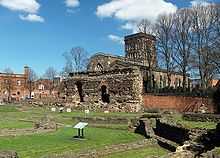
Roman
It is believed that the Romans arrived in the Leicester area around AD 47, during their conquest of southern Britain.[25] The Corieltauvian settlement lay near a bridge on the Fosse Way, a Roman road between the legionary camps at Isca (Exeter) and Lindum (Lincoln). It remains unclear whether the Romans fortified and garrisoned the location, but it slowly developed from around the year 50 onwards as the tribal capital of the Corieltauvians under the name Ratae Corieltauvorum. In the 2nd century, it received a forum and bathhouse. In 2013, the discovery of a Roman cemetery found just outside the old city walls and dating back to AD 300 was announced.[25] The remains of the baths of Roman Leicester can be seen at the Jewry Wall; recovered artifacts are displayed at the adjacent museum.
Medieval
Knowledge of the town following the Roman withdrawal from Britain is limited. Certainly there is some continuation of occupation of the town, though on a much reduced scale in the 5th and 6th centuries. Its memory was preserved as the Cair Lerion[10] of the History of the Britons.[11] Following the Saxon invasion of Britain, Leicester was occupied by the Middle Angles and subsequently administered by the kingdom of Mercia. It was elevated to a bishopric in either 679 or 680; this see survived until the 9th century, when Leicester was captured by Danish Vikings. Their settlement became one of the Five Burghs of the Danelaw, although this position was short-lived. The Saxon bishop, meanwhile, fled to Dorchester-on-Thames and Leicester did not become a bishopric again until the Church of St Martin became Leicester Cathedral in 1927. The settlement was recorded under the name Ligeraceaster in the early 10th century.
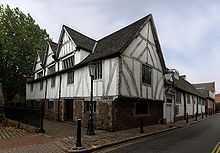
Following the Norman conquest, Leicester was recorded by William's Domesday Book as Ledecestre. It was noted as a city (civitas) but lost this status in the 11th century owing to power struggles between the Church and the aristocracy and did not become a legal city again until 1919.
Geoffrey of Monmouth composed his pseudohistorical[26][27] History of the Kings of Britain around the year 1136, mentioning the town and its King Leir.[14] Geoffrey claimed Cordelia had buried her father beneath the river in a chamber dedicated to Janus and that his feast day was an annual celebration.[28] William Shakespeare's King Lear was loosely based on this story and there is now a statue of Lear in Watermead Country Park.
At the end of the War of the Roses, King Richard III was buried in Leicester's Greyfriars Church, whose ruins are now located beneath a car park. There was a legend that his corpse had been cast into the river, while some historians[29] argued that his tomb and remains were destroyed during the dissolution of the monasteries under Henry VIII. However, in September 2012, an archaeological investigation discovered a skeleton[30] which was subsequently verified to be related to two descendants of Richard III's sister.[31] In 2015 Richard III was reburied in pride of place near the high altar in Leicester Cathedral.
Modern
- Tudor
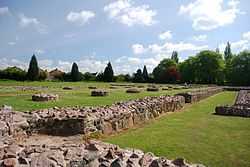
On 4 November 1530, Cardinal Thomas Wolsey was arrested on charges of treason and taken from York Place. On his way south to face dubious justice at the Tower of London, he fell ill. The group escorting him was concerned enough to stop at Leicester. There, Wolsey's condition quickly worsened. He died on 29 November 1530 and was buried at Leicester Abbey, now Abbey Park.
Lady Jane Grey, a great-granddaughter of Henry VII who reigned as England's uncrowned Queen Regnant for nine days in June of 1553, was born at Bradgate Park near Leicester around 1536.[32]
Queen Elizabeth I's intimate and former suitor, Robert Dudley, was given the Earldom of Leicester.
- Civil War
Leicester was a Roundhead stronghold during the English Civil War. In 1645, Prince Rupert decided to attack the city to draw the New Model Army away from the Royalist headquarters of Oxford. Royalist guns were set up on Raw Dykes and, after an unsatisfactory response to a demand for surrender, the Newarke was stormed and the city was sacked on 30 May. Hundreds of people were killed by Rupert's cavalry and reports of the severity of the sacking were further exaggerated by the Parliamentary press in London.[33]
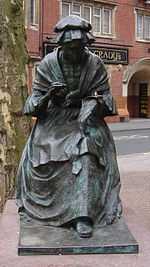
Leicester, Hotel Street
- Industrial Era
The construction of the Grand Union Canal in the 1790s linked Leicester to London and Birmingham; by 1832, the railway had arrived in Leicester. The Leicester and Swannington provided a supply of coal to the town from nearby collieries and the Midland Counties linked the town to the national network by 1840. A direct link to London's St Pancras Station was established by the Midland Main Line in the 1860s. These developments encouraged and accompanied a process of industrialisation which intensified throughout the reign of Queen Victoria. Factories began to appear, particularly along the canal and river, and districts such as Frog Island and Woodgate were the locations of numerous large mills. Between 1861 and 1901, Leicester's population increased from 68 000 to 212 000 and the proportion employed in trade, commerce, building, and the city's new factories and workshops rose steadily. Hosiery, textiles, and footwear became the major industrial employers: manufacturers such as N. Corah & Sons and the Cooperative Boot and Shoe Company were opening some of the largest manufacturing premises in Europe. They were joined, in the latter part of the century, by engineering firms such as Kent Street's Taylor & Hubbard (crane makers & founders), Vulcan Road's William Gimson & Company (steam boilers & founders), and Martin Street's Richards & Company (steel works & founders).
The politics of Victorian Leicester were lively and very often bitter. Years of consistent economic growth meant that living standards generally increased, but Leicester was a stronghold of Radicalism. Thomas Cooper, the Chartist, kept a shop in Church Gate. There were serious Chartist riots in the town in 1842 and again six years later.[34] The Leicester Secular Society was founded in 1851 but secularist speakers such as George Holyoake were often denied the use of speaking halls. It was not until 1881 that Leicester Secular Hall was opened. The second half of the 19th century also witnessed the creation of many other institutions, including the town council, the Royal Infirmary, and the Leicester Constabulary. It also benefited from general acceptance that municipal organisations had a responsibility to provide for the town's water supply, drainage, and sanitation.
Leicester became a county borough in 1889, although it was abolished with the rest in 1974 as part of the Local Government Act. The city regained its unitary status apart from Leicestershire in 1997. The borough had been expanding throughout the 19th century, but grew most most notably when it annexed Belgrave, Aylestone, North Evington, Knighton, and Stoneygate in 1892.
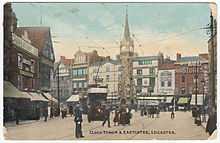
- 20th century
In 1900, the Great Central Railway provided another link to London, but the rapid population growth of the previous decades had already begun to slow by the time of Queen Victoria's death in 1901. World War I and the subsequent epidemics had further impacts. Nonetheless, Leicester was finally recognised as a legal city once more in 1919 and, in 1925, again became a cathedral city on the consecration of St Martin's. It obtained its current boundaries in 1935, with the annexation of the remainder of Evington, Humberstone, Beaumont Leys, and part of Braunstone.
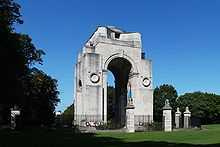
Leicester's diversified economic base and lack of dependence on primary industries meant that it was much better placed than many other cities to weather the tariff wars of the 1920s and Great Depression of the 1930s. The Bureau of Statistics of the newly formed League of Nations identified Leicester in 1936 as the 2nd-richest city in Europe[35] and it became an attractive destination for refugees fleeing persecution and political turmoil in continental Europe. Firms such as Corah and Liberty Shoes used their reputation for producing high-quality products to expand their businesses. These years witnessed the growth in the city of trade unionism and particularly the co-operative movement. The Co-op became an important employer and landowner; when Leicester played host to the Jarrow March on its way to London in 1936, the Co-op provided the marchers with a change of boots. In 1938, Leicester was selected as the base for Squadron 1F, the first A.D.C.C (Air Defence Cadet Corp), the predecessor of the Air Training Corps.
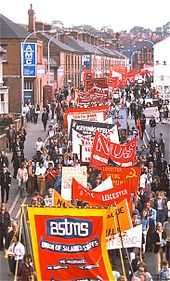
The years after World War II, particularly from the 1960s onwards, brought many social and economic challenges.
Mass housebuilding continued across Leicester for some 30 years after 1945. Existing housing estates such as Braunstone were expanded, while several completely new estates – of both private and council tenure – were built. The last major development of this era was Beaumont Leys in the north of the city, which was developed in the 1970s as a mix of private and council housing. There was a steady decline in Leicester's traditional manufacturing industries and, in the city centre, working factories and light industrial premises have now been almost entirely replaced. Many former factories, including some on Frog Island and at Donisthorpe Mill, have been badly damaged by fire. Rail and barge were finally eclipsed by automotive transport in the 1960s and '70s: the Great Central and the Leicester & Swannington both closed and the northward extension of the M1 motorway linked Leicester into England's growing motorway network. With the loss of much of the city's industry during the 1970s and '80s, some of the old industrial jobs were replaced by new jobs in the service sector, particularly in retail. The opening of the Haymarket Shopping Centre in 1971 was followed by a number of new shopping centres in the city, including St Martin's Shopping Centre in 1984 and the Shire Shopping Centre in 1992.[36] The Shires was subsequently expanded in September 2008 and rebranded as Highcross. By the 1990s, as well, Leicester's central position and good transport links had established it as a distribution centre; the southwestern area of the city has also attracted new service and manufacturing businesses.
Immigration
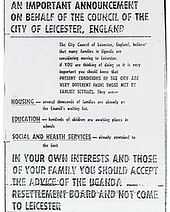
Since the war, Leicester has experienced large scale immigration from across the world. Immigrant groups today make up around 40% of Leicester's population, making Leicester one of the most ethnically diverse cities in the United Kingdom. Many Polish servicemen were prevented from returning to their homeland after the war by the communist regime, and they established a small community in Leicester. Economic migrants from the Irish Republic continued to arrive throughout the post war period. Immigrants from the Indian sub-continent began to arrive in the 1960s, their numbers boosted by Asians arriving from Kenya and Uganda in the early 1970s.[37][38]
In 1972, Idi Amin announced that the entire Asian community in Uganda had 90 days to leave the country.[39] Shortly thereafter, the Leicester City Council launched a campaign aimed at dissuading Ugandan Asians from migrating to the city.[40] The ads did not have their intended effect, instead making more migrants aware of the possibility of settling in Leicester.[41] Nearly a quarter of initial Ugandan refugees (around 5000 to 6000) settled in Leicester, and by the end of the 1970s around another quarter of the initially dispersed refugees had made their way to Leicester.[42] Officially, the adverts were taken out for fear that immigrants to Leicester would place pressure on city services and at least one person who was a city councillor at the time says that he believes they were placed for racist reasons.[43] The initial advertisement was widely condemned, and taken as a marker of anti-Asian sentiment throughout Britain as a whole, although the attitudes that resulted in the initial advertisement were changed significantly in subsequent decades.[44] Recent Leicester councillors have expressed significant regret for the council having run the advertisement.[43]
In the 1990s, a group of Dutch citizens of Somali origin settled in the city. Since the 2004 enlargement of the European Union a significant number of East European migrants have settled in the city. While some wards in the northeast of the city are more than 70% South Asia, wards in the west and south are all over 70% white. The Commission for Racial Equality (CRE) had estimated that by 2011 Leicester would have approximately a 50% ethnic minority population, making it the first city in Britain not to have a white British majority.[45] This prediction was based on the growth of the ethnic minority populations between 1991 (Census 1991 28% ethnic minority) and 2001 (Census 2001 – 36% ethnic minority). However Professor Ludi Simpson at the University of Manchester School of Social Sciences said in September 2007 that the CRE had "made unsubstantiated claims and ignored government statistics" and that Leicester's immigrant and minority communities disperse to other places.[46][47] The Leicester Multicultural Advisory Group is a forum, set up in 2001 by the editor of the Leicester Mercury, to co-ordinate community relations with members representing the council, police, schools, community and faith groups, and the media.
Geography
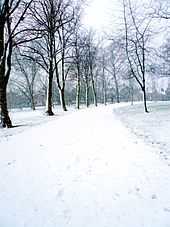
Wards of Leicester
Leicester is divided into several administrative wards, that correspond to many historical suburbs, villages and districts in the unitary authority area:
| Ward | Suburbs, villages and districts |
|---|---|
| Abbey | Abbey Ward, Frog Island, Mowmacre Hill, Stocking Farm |
| Aylestone | Aylestone, Aylestone Park, Saffron |
| Beaumont Leys | Beaumont Leys, Heathley Park |
| Belgrave | Belgrave |
| Braunstone Park & Rowley Fields | Braunstone, Rowley Fields |
| Castle | City Centre, Blackfriars, Clarendon Park, Southfields |
| Charnwood | Northfields |
| Coleman | Crown Hills, North Evington |
| Evington | Evington, Goodwood, Rowlatts Hill |
| Eyres Monsell | Eyres Monsell, Saffron |
| Fosse | Newfoundpool, West End, Woodgate |
| Freemen | Knighton Fields, Saffron |
| Humberstone & Hamilton | Hamilton, Humberstone, Humberstone Garden Suburb, Netherhall |
| Knighton | Stoneygate, Knighton, South Knighton, West Knighton |
| Latimer | St. Mark's |
| New Parks | New Parks |
| Rushey Mead | Rushey Mead |
| Spinney Hills | Spinney Hills, St. Matthew's, St. Peter's |
| Stoneygate | Highfields, Horston Hill, Evington Valley |
| Thurncourt | Thurnby Lodge |
| Westcotes | Bede Island |
| Western Park | Western Park, Dane Hills |
The Office for National Statistics has defined a Leicester Urban Area, which consists of the conurbation of Leicester, although it has no administrative status. The area contains the unitary authority area and several towns, villages and suburbs outside the city's administrative boundaries.
Climate
Leicester experiences a maritime climate with mild to warm summers and cool winters, rain spread throughout the year, and low sunshine levels. The nearest official Weather Station was Newtown Linford, about 5 miles (8.0 km) North West of Leicester city centre and just outside the edge of the urban area. However, observations stopped in 2003. The current nearest Weather Station is Market Bosworth, about 10 miles (16 km) west of the city centre.
The highest temperature recorded at Newtown Linford was 34.5 °C (94.1 °F)[48] during August 1990, although a temperature of 35.1 °C (95.2 °F) was achieved at Leicester University during August 2003.[49] More typically the highest temperature would reach 28.7 °C (83.7 °F)[50] – the average annual maximum. 11.3 days[51] of the year should attain a temperature of 25.1 °C (77.2 °) or above.
The lowest temperature recorded at Newtown Linford was −16.1 °C (3.0 °F)[52] during January 1963. Typically, 54.9 air frosts will be recorded during the course of the year.
Rainfall averages 684.4 mm[53] per year, with 1 mm or more falling on 120.8 days.[54] All averages refer to the period 1971–2000.
| Climate data for Newtown Linford, elevation 119m, 1971–2000, extremes 1960–2003 | |||||||||||||
|---|---|---|---|---|---|---|---|---|---|---|---|---|---|
| Month | Jan | Feb | Mar | Apr | May | Jun | Jul | Aug | Sep | Oct | Nov | Dec | Year |
| Record high °C (°F) | 13.6 (56.5) |
17.9 (64.2) |
21.7 (71.1) |
23.9 (75) |
26.5 (79.7) |
31.5 (88.7) |
32.3 (90.1) |
34.5 (94.1) |
27.7 (81.9) |
23.3 (73.9) |
16.2 (61.2) |
14.6 (58.3) |
34.5 (94.1) |
| Average high °C (°F) | 6.3 (43.3) |
6.9 (44.4) |
9.7 (49.5) |
12.2 (54) |
16.0 (60.8) |
18.6 (65.5) |
21.4 (70.5) |
21.1 (70) |
17.7 (63.9) |
13.5 (56.3) |
9.1 (48.4) |
7.1 (44.8) |
13.3 (55.9) |
| Average low °C (°F) | 0.5 (32.9) |
0.5 (32.9) |
2.1 (35.8) |
3.3 (37.9) |
6.0 (42.8) |
8.7 (47.7) |
10.8 (51.4) |
10.7 (51.3) |
8.8 (47.8) |
6.0 (42.8) |
2.8 (37) |
1.3 (34.3) |
7.1 (44.8) |
| Record low °C (°F) | −16.1 (3) |
−11.7 (10.9) |
−11.1 (12) |
−6.6 (20.1) |
−3.3 (26.1) |
−0.9 (30.4) |
2.8 (37) |
2.8 (37) |
0.0 (32) |
−6.2 (20.8) |
−7.4 (18.7) |
−14.4 (6.1) |
−16.1 (3) |
| Average precipitation mm (inches) | 61.65 (2.4272) |
48.91 (1.9256) |
51.86 (2.0417) |
43.86 (1.7268) |
50.83 (2.0012) |
63.07 (2.4831) |
46.08 (1.8142) |
59.25 (2.3327) |
61.50 (2.4213) |
60.58 (2.385) |
60.34 (2.3756) |
68.82 (2.7094) |
684.37 (26.9437) |
| Source: KNMI[55] | |||||||||||||
Government
On 1 April 1997, Leicester City Council became a unitary authority. Before then, local government was a two-tier system: the city and county councils were responsible for different aspects of local government services: this system is still in place in the rest of Leicestershire. Leicestershire County Council retained its headquarters at County Hall in Glenfield, just outside the city boundary but within the urban area. The administrative offices of Leicester City Council are in the centre of the city at the New Walk Centre, soon to be abandoned and demolished, and other office buildings near Welford Place. Some services (particularly the police and the ambulance service) still cover the whole of the city and county, but for the most part the two councils are independent.
After a long period of Labour administration (since 1979), the city council from May 2003 was run by a Liberal Democrat/Conservative coalition under Roger Blackmore, which collapsed in November 2004. The minority Labour group ran the city until May 2005, under Ross Willmott, when the Liberal Democrats and Conservatives formed a new coalition, again under the leadership of Roger Blackmore.
In the local government elections of 3 May 2007, Leicester's Labour Party once again took control of the council in what can be described as a landslide victory. Gaining 18 new councillors, Labour polled on the day 38 councillors, creating a governing majority of +20. Significantly however, the Green Party gained its first councillors in the Castle Ward, after losing on the drawing of lots in 2003, though one of these subsequently resigned and the seat was lost to Labour in a by-election on 10 September 2009. The Conservative Party saw a decrease in their representation. The Liberal Democrat Party was the major loser, dropping from 25 councillors in 2003 to only 6 in 2007.
In the local government elections of 5 May 2011, Labour won 52 of the city's 54 seats, with the Conservatives and Liberal Democrats winning one seat each.[56]
Leicester is divided into three Parliamentary constituencies, all controlled by the Labour Party : Leicester East, represented by Keith Vaz, Leicester South, represented by Jon Ashworth, and Leicester West represented by Liz Kendall. In April 2011 the then Leicester South MP Sir Peter Soulsby left the House of Commons to seek election as Mayor of Leicester.
On 5 May 2011, Peter Soulsby became the first directly elected Mayor of Leicester.
Before the creation of an elected executive Mayor the post of civic mayor and later Lord Mayor existed. The first mayor of Leicester was the Norman knight "Peter fitz Roger" (Peter son of Roger) in 1251.[57][58] Following the restoration of city status this title was elevated to "Lord Mayor." In 1987 the first Asian Mayor of Leicester was indirectly elected by the councillors, Councillor Gordhan Parmar.[59] After institution of a directly elected mayor in 2011 the Lord Mayor of Leicester still exists as a ceremonial role under Leicester City Council.[60]
Coat of arms
The Corporation of Leicester's coat of arms was first granted to the city at the Heraldic Visitation of 1619, and is based on the arms of the first Earl of Leicester, Robert Beaumont. The charge is a cinquefoil 'ermine', on a red field, and this emblem is used by the city council.
After Leicester became a city again in 1919, the city council applied to add to the arms. Permission for this was granted in 1929, when the supporting lions, from the Lancastrian Earls of Leicester, were added.
The motto "Semper Eadem" was the motto of Queen Elizabeth I, who granted a royal charter to the city. It means "always the same" but with positive overtones meaning unchanging, reliable or dependable. The crest on top of the arms is a white or silver legless wyvern with red and white wounds showing, on a wreath of red and white. The legless wyvern distinguishes it as a Leicester wyvern as opposed to other wyverns. The supporting lions are wearing coronets in the form of collars, with the white cinquefoil hanging from them.
Demography
| Leicester compared[61] | |||
|---|---|---|---|
| UK Census 2011 | Leicester | East Midlands | England |
| Total population | 329,839 | 4,533,222 | 53,012,456 |
| Foreign born | 33.6% | 9.9% | 13.8% |
| White (2001) | 63.9% | 93.5% | 90.9% |
| White (2011) | 50.6% | 89.3% | 85.5% |
| South Asian (2001) | 29.9% | 4.0% | 4.6% |
| South Asian (2011) | 31.8% | 5.1% | 5.5% |
| Black (2001) | 3.1% | 0.9% | 2.3% |
| Black (2011) | 6.3% | 1.7% | 3.4% |
| Mixed (2001) | 2.3% | 1.9% | 1.3% |
| Mixed (2011) | 3.5% | 1.4% | 2.2% |
| East Asian and Other (2001) | 0.8% | 0.5% | 0.9% |
| East Asian and Other (2011) | 5.3% | 1.3% | 2.2% |
| Christian | 32.4% | 58.8% | 59.4% |
| Muslim | 18.6% | 3.1% | 5.0% |
| No religion | 17.4% | 15.2% | 24.7% |
| Hindu | 15.2% | 2.0% | 1.5% |
| English as a main language | 69.3% | 93.3% | 90.9% |
The United Kingdom Census 2001 showed a total resident population for Leicester of 279,921, a 0.5% decrease from the 1991 census.[62] Approximately 62,000 were aged under 16, 199,000 were aged 16–74, and 19,000 aged 75 and over.[62] 76.9% of Leicester's population claimed that they were born in the UK, according to the 2001 UK Census. Mid-year estimates for 2006 indicate that the population of the City of Leicester stood at 289,700, making Leicester the most populous city in the East Midlands.[63]
The population density was 3,814/km2 (9,880/sq mi)[64] and for every 100 females, there were 92.9 males. Of those aged 16–74 in Leicester, 38.5% had no academic qualifications, significantly higher than 28.9% in all of England.[65] 23.0% of Leicester's residents were born outside the United Kingdom, more than double the English average of 9.2%.[66]
In terms of ethnic composition, according to the 2011 census, 50.6% of the population was White (45.1% White British, 0.8% White Irish, 0.1% Gypsy or Irish Traveller, 4.6% Other White), 37.1% Asian (28.3% Indian, 2.4% Pakistani, 1.1% Bangladeshi, 1.3% Chinese, 4.0% Other Asian), 3.5% of mixed race (1.4% White and Black Caribbean, 0.4% White and Black African, 1.0% White and Asian, 0.7% Other Mixed), 6.3% Black (3.8% African, 1.5% Caribbean, 1.0% Other Black), 1.0% Arab and 1.6% of other ethnic heritage.[2]
Christians were the largest religious group in the city in 2011 at 32.4%, with Muslims next (18.6%), followed by Hindus (15.2%), Sikhs (4.4%), Buddhists (0.4%), and Jews (0.1%). In addition, 0.6% belonged to other religions, 22.8% identified with no religion and 5.6% did not respond to the question.[67] There are three active synagogues in the city: one Progressive, one Orthodox, and one Messianic.
Leicester is the second fastest growing city in the country.[68]
Languages
A demographic profile of Leicester published by the city council in 2008 noted:
Alongside English, around 70 languages and/or dialects spoken in the city. In addition to English, eight languages are commonly spoken: Gujarati is the preferred language of 16% of the city's residents, Punjabi 3%, Somali 4% and Urdu 2%. Other smaller language groups include Hindi, Bengali and Polish. ... With continuing migration into the city, new languages and or dialects from Africa, the Middle East and Eastern Europe are also being spoken in the city. In primary schools in Leicester, English is not the 'preferred' language of 45% of pupils and the proportion of children whose first language is known, or believed to be, other than English, is significantly higher than other cities within the region, or within the UK.[69]
Population change
| Population growth in Leicester since 1901 | ||||||||||
|---|---|---|---|---|---|---|---|---|---|---|
| Year | 1901 | 1911 | 1921 | 1931 | 1939 | 1951 | 1961 | 1971 | 2001 | 2011 |
| Population | 211,579 | 227,222 | 234,143 | 239,169 | 261,339 | 285,181 | 273,470 | 284,208 | 279,921 | 329,600 |
| Source: A Vision of Britain through Time | ||||||||||
Economy

Leicester has the largest economy in the East Midlands. A recent study by emda/Experian estimated the GVA to be £15.3 billion.[70] Companies that have their head office based in the area include Dunelm Mill, Next, Jessops, Shoe Zone, Brantano Footwear & Goldsmiths. British Gas, Caterpillar, Wal-Mart, Topps Tiles and DHL all have sites in Leicester.[71]
The city has historically had a strong association with the production of textiles, clothing and shoes. While important companies such as Corah, Liberty Shoes and Equity Shoes have closed, companies such as Next and Boden are still active in the city. Moreover, in recent years the higher transport prices and longer lead-times associated with globalised production in Asia mean that some textile manufacturers are locating to the city.[72][73]
Engineering
Engineering is an important part of the economy of Leicester. Companies include Jones & Shipman (machine tools and control systems), Richards Engineering (foundry equipment), Transmon Engineering (materials handling equipment) and Trelleborg (suspension components for rail, marine, and industrial applications). Local commitment to nurturing the upcoming cadre of British engineers includes apprenticeship schemes with local companies, and academic-industrial connections with the engineering departments at Leicester University, De Montfort University, and Loughborough University. Leicester was also home to the famous Gents' of Leicester clock manufacturers.
Shopping
In 2008 Leicester was positioned thirteenth in the retail shopping league of England (CACI Retail Footprint 2008).
There are two main shopping centres in Leicester – the Haymarket Shopping Centre and Highcross Leicester. The Haymarket Shopping Centre was opened on the site in 1974, and was the first to be built in the City, with parking for up to 500 cars on several levels, two levels of shopping with bus station, and was also the site of the former Haymarket Theatre. Highcross Leicester opened in 2008 after work to redevelop "The Shires Centre" was completed at a cost of £350 million (creating 120 stores, 15 restaurants, a cinema, 110,000 m2 of shopping space). Smaller shopping centres include St Martin's Square. The Leicester Lanes area has numerous designer and specialist shops. Leicester Market is the largest outdoor covered market in Europe selling a wide variety of goods. The Golden Mile is the name given to a stretch of Belgrave Road renowned for its authentic Indian restaurants, sari shops, and jewellers; the Diwali celebrations in Leicester are focused on this area and are the largest outside India[74]
Leicester has a number of department stores including Fenwick, House of Fraser, John Lewis, Dunelm Mill and Debenhams.
Food and drink
Henry Walker was a successful pork butcher who moved from Mansfield to Leicester in the 1880s to take over an established business in High Street. The first Walker's production line was in the empty upper storey of Walker's Oxford Street factory in Leicester. In the early days the potatoes were sliced up by hand and cooked in an ordinary fish and chip fryer. In 1971 the Walker's crisps business was sold to Standard Brands, an American firm, who sold on the company to Frito-Lay. Walker's crisps currently makes 10 million bags of crisps per day at two factories in Beaumont Leys, and is the UK's largest grocery brand.[75] The Beaumont Leys manufacturing plant is the largest crisp factory in the world.[76]
Meanwhile the sausage and pie business was bought out by Samworth Brothers in 1986. Production outgrew the Cobden Street site and pork pies are now manufactured at a meat processing factory and bakery in Beaumont Leys, coincidentally situated near the separately owned crisp factories. Sold under the Walker's name and under UK retailers own brands such as Tesco's Finest, over three million hot and cold pies are made each week.[77] Henry Walker's butcher shop at 4–6 Cheapside sold Walker's sausages and pork pies until March 2012 when owner Scottish Fife Fine Foods went bust, although the shop is temporarily open and selling Walker's pies for the Christmas 2012 season.[78]
Leicester Market is the largest outdoor covered marketplace in Europe and selling fruit, vegetables, fresh fish and meat. Every year during the summer the Leicester City Council hold cultural festivals here. In 2009 the Leicester Mela was held in the market area. In 2011 a new area called "Market Corner" was opened with various different food and drink on offer on Fridays and Saturdays. The market was given royal consent in 1229 by Henry III. One famous stallholder family is the Linekers, who have operated a fruit and vegetable store since the late 1960s. Other markets in Leicester include Beaumont Leys Market. There are other markets, including the farmer's market and the continental markets usually held on Humberstone Gate or Gallowtree Gate.
Financial and business services
Financial and business service companies with operations in Leicestershire include Santander (previously Alliance & Leicester), Royal Bank of Scotland, Barclays Bank, State Bank of India, ICICI Bank, Bank of Baroda and HSBC. All of the major accounting firms have offices in Leicester. One of Aviva's seven UK administrative hubs is based in Leicester.
Statistics
This is a chart of trend of regional gross value added of Leicester at current basic prices published (pp. 240–253) by Office for National Statistics with figures in millions of British Pounds Sterling.
| Year | Regional Gross Value Added[79] | Agriculture[80] | Industry[81] | Services[82] |
|---|---|---|---|---|
| 1995 | | | | |
| 2003 | | | |
Births, marriages and deaths
The staff at the Leicester office registers 9,500 births and 5,700 deaths annually. In addition around 1,000 marriage ceremonies take place within the building every year together with an increasing number of civil partnership registrations. As part of the legal preliminaries to their wedding the citizens of the city of Leicester who wish to marry anywhere other than the Church of England must give a legal notice of their intention to marry. In the course of a year more than 2,000 notices are entered in the records of this office.
The original records of all births, marriages and deaths which have taken place in Leicester since 1837 are kept at the register office. Every year approximately 12,000 certified copies are issued from these historic records.
Business awards
The Leicestershire Business Awards has categories including Investing in Leicestershire, Contribution to the Community, and Entrepreneur of the Year.
Recent Leicestershire winners of the Queen's Award for Enterprise are Guidance Ltd, listed on the Lord Lieutenant's website. Guidance Monitoring Limited (GML) specialises in the design and manufacture of sophisticated electronic tagging/tracking systems for asset protection and personnel monitoring including for security and criminal justice applications.
Landmarks
There are ten Scheduled Monuments in Leicester and thirteen Grade I listed buildings: some sites, such as Leicester Castle and the Jewry Wall, appear on both lists.
20th-century architecture: Leicester University Engineering Building (James Stirling & James Gowan : Grd II Listed), Kingstone Department Store, Belgrave Gate (Raymond McGrath : Grd II Listed)
Older architecture:
Tourist: Discover Leicester Tour is an open top tour bus linking many of the Leicestershire tourist sites in and around the city. See .
Parks: Abbey Park, Botanic Gardens, Castle Gardens, Gorse Hill City Farm, Grand Union Canal, Knighton Park, Nelson Mandela Park, River Soar, Victoria Park, Watermead Country Park.
Industry: Abbey Pumping Station, National Space Centre, Great Central Railway.
Places of worship: Shree Jalaram Prarthana Mandal (Hindu temple),[83] the Stake Centre of the LDS Church's Leicester England Stake, Jain Centre,[84] Leicester Cathedral, Leicester Central Mosque,[85] Masjid Umar[86] (Mosque),[87] Guru Nanak Gurdwara (Sikh), Neve Shalom Synagogue (Progressive Jewish).
Historic buildings: Town Hall, Guildhall, Belgrave Hall, Jewry Wall, Secular Hall, Abbey, Castle, St Mary de Castro, The City Rooms, Newarke Magazine Gateway.
Shopping: Haymarket Shopping Centre, Highcross, Market, Golden Mile, Beaumont Shopping Centre, Fosse Shopping Park, St Martin's Square, Silver Arcade.
Sport: King Power Stadium – Leicester City FC, Welford Road – Leicester Tigers, Grace Road – Leicestershire County Cricket Club, Beaumont Sports Complex - Leicester Lions Speedway, John Sanford Sports Centre – Leicester Riders, Saffron Lane sports centre – Leicester Coritanian Athletics Club
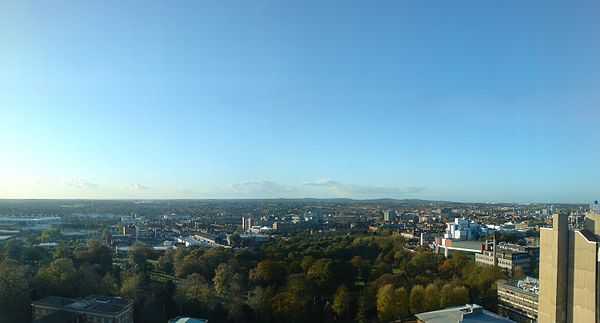
Transport
Railway

The rail network is of growing importance in Leicester, and with the start of Eurostar international services from London St Pancras International in November 2007 giving Leicester railway station almost direct links to the continent, this growth is expected to continue.
East Midlands Trains are the InterCity operator running 'fast' and 'semi-fast' services to and from London to northern England, and provide local services throughout the East Midlands, regional services to the West Midlands and East Anglia are provided by CrossCountry.
Rail routes run north–south through Leicester along the route known as the Midland Main Line, going south to Bedford, Luton and London; and north to Lincoln, Sheffield, Leeds and York. Junctions north and south of the station link the east–west cross country route, going east to Cambridge, Stansted Airport and Norwich; and west to Nuneaton and Birmingham. Leicester is 99 miles (159 km) from London on the Midland Main Line, the fastest trains taking 1 hour and 07 minutes. Journeys to Sheffield take around 1 hour, Leeds and York are approximately a 2-hour journey. Birmingham and Peterborough are around 1 hour away.
Passengers using the railway station can include a PlusBus ticket with their train ticket which gives unlimited bus travel in a designated area.
Network Rail has plans afoot to re-develop the station incorporating the city council's plans for the surrounding area.[88]
Great Central Railway
Leicester was also on a competing line from London to the North, built by the Great Central Railway in the late 1890s. Served by Leicester Central railway station, the Great Central Main Line closed as a through route in the late 1960s. A preserved section remains: from the newly opened Leicester North railway station (parts of the original route through Leicester have now been built on) to Loughborough is now a heritage steam railway.
Motorways
Leicester is close to the heart of the M1 motorway at Junction 21. This section is considered to be the busiest part in the country. The M69 motorway starts at Junction 21 and runs to the M6 Motorway and is contiguous with Coventry's eastern bypass.
Airport
East Midlands Airport is near Castle Donington which is in North West Leicestershire. It's served by low-cost international airlines like Ryanair, Jet2.com & Fly be and serves charter holidays like Thomson Holidays. This makes Leicester easily accessible from other parts of the world providing regular services to many principal European destinations. This includes Amsterdam, Berlin & Paris. Also there are internal flights to Belfast, Edinburgh & Glasgow and limited services to transcontinental destinations such as Barbados, Mexico & Orlando.
Also Birmingham Airport is only about a 45 or 50-minute drive from Leicester, and London Luton Airport can be reached in an hour or just over. Luton serves similar destinations to East Midlands though Luton services are more regular. Birmingham airport generally flies to places like Amsterdam, Brussels, Frankfurt, Munich & Paris with airlines like Air France, KLM & Lufthansa.
Leicester's other local airport is Leicester Airport at Stoughton, Leicestershire.
Buses
Leicester has two main bus stations: St Margaret's Bus Station and Haymarket Bus Station.
There are three permanent Park and Ride sites located at Meynells Gorse (Leicester Forest East), Birstall and Enderby; buses operate every 15 mins from all sites. The park and ride services are branded as quicksilver shuttle and are contracted to Roberts Coaches from the City Council and County Council, buses use a purpose built terminal near St. Nicholas Circle.
The main bus operators for Leicester are Arriva, Centrebus, First Leicester, Hinckley Bus (Part of Arriva Midlands), Kinchbus, Leicester Bus, Roberts Coaches and Stagecoach Midlands.
National Cycle Network
National Cycle Network Route 6 passes through Leicestershire along with other secondary routes. The Leicester Bike Park is also located in Town Hall Square. 'Cycle Works' Bike Mechanic Training Centre is located in Wellington Street Adult Education Centre and former Central Lending Library.
Education
Schools
Leicester is home to a number of comprehensive schools and independent schools. Leicester Grammar School, a HMC member school, was founded in the 1980s after the city's loss of its state-funded grammar schools. There are three sixth form colleges, all of which were previously grammar schools.
The Leicester City Local Education Authority initially had a troubled history when formed in 1997 as part of the local government reorganisation – a 1999 Ofsted inspection found "few strengths and many weaknesses", although there has been considerable improvement since then. While many state schools provide a good standard of education, there have been problems with one or two of the large community colleges, in particular New College on Glenfield Road. However, recent changes of leadership at New College have seen a turnaround in the school's prospects.
Recent plans to improve the city's education system included the opening of Samworth Enterprise Academy, an academy whose catchment area draws in children from the Saffron and Eyres Monsell estates, co-sponsored by the Church of England and David Samworth, chairman of Samworth Brothers. State school status has also been granted to the Madani Schools Federation, a Leicester Islamic secondary school. The city's special schools are currently undergoing reorganisation.
Under the "Building Schools for the Future" project, Leicester City Council has contracted with developers Miller Consortium for £315 million to rebuild Beaumont Leys School, Judgemeadow Community College, the City of Leicester College in Evington, and Soar Valley College in Rushey Mead, and to refurbish Fullhurst Community College in Braunstone.[89]
Leicester City Council underwent a major reorganisation of children's services in 2006, creating a new Children & Young People's Services department.
Leicester was one of the last places in the UK where milk was supplied to primary schools in third pint glass bottles. In 2007 the supplier changed to plastic bottles.
Tertiary

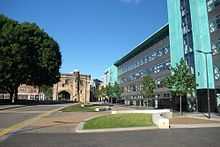
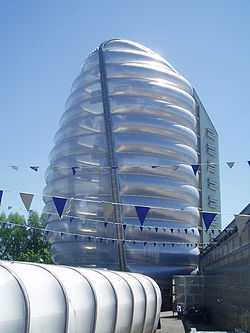
Leicester is home to two universities, the University of Leicester, which attained its Royal Charter in 1957 and is one of Britain's leading universities ranked 12th by the 2009 Complete University Guide, and De Montfort University, which opened in 1969 as Leicester Polytechnic and achieved university status in 1992. The Leicester Business School was regarded by The Sunday Times as one of the top 10 business schools in the UK,[30] and the 2007 National Student Survey ranked it seventh out of 110 institutions for student satisfaction.
It is also home to the National Space Centre located off Abbey Lane, due in part to the University of Leicester being one of the few universities in the UK to specialise in space sciences.
Culture
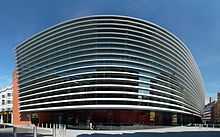
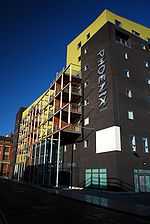
The city hosts an annual Pride Parade (Leicester Pride), a Caribbean Carnival (the largest in the UK outside London), the largest Diwali celebrations outside of India and the largest comedy festival in the UK Leicester Comedy Festival. One of the best known places in the city is Melton Road, near the city centre, which contains many diverse retail stores and restaurants for both locals and tourists. From clothing to fine cuisines, specialist bridal/groom makeup and home appliances, this road promotes and holds many authentic cultures globally. Melton Road is regarded as the pin point of Leicester as a multifaith city. For many residents of Leicester, Melton Road is a place with strong links to their roots and origins. From an ethnic point of view, this is just one of the many sites within the city that enables every person to feel a sense of homeliness and strong pride of culture.
The Leicester International Short Film Festival is an annual event; it began life with humble beginnings in 1996 under the banner title of "Seconds Out". It has become one of the most important short film festivals in the UK It usually runs in early November, with venues including the Phoenix Arts Centre.
Arts venues in the city include:
- Curve: New purpose-designed performing arts centre, designed by Rafael Viñoly, opened in Autumn 2008,[90] replaced the Haymarket Theatre
- The De Montfort Hall
- The Y Theatre
- The Little Theatre
- Upper Brown Street (formerly the Phoenix Arts Centre)
- The City Gallery, one of the region's leading contemporary art galleries
- The Peepul Centre, Designed by Andrzej Blonski Architects, the £15 million building was opened in 2005 and houses an auditorium, restaurant, cyber café, gym and dance studio for the local people, as well as being used for conferences and events. The centre has even been host to former Prime Minister Gordon Brown and other senior Labour Party figures for hustings during the deputy leadership contest.
- Phoenix Square, which replaced the Phoenix Arts Centre in 2009.
- Fabrika The Independent Arts Centre, 68–70 Humberstone Gate. An Independent Art centre designed to help everyone in the community in a number of different ways.
- HQ {Graffiti} Art Gallery & Recording Studio creative hub, an organic, unique, free artistic centre. Located at 38 Charles Street, HQ is home to the highly regarded LCMP CIC & Co-operative,(Leicester Community Music Project).
Museums
-
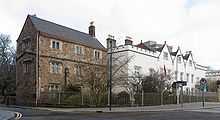
Newarke Houses Museum (Grade II*)
Music
While Leicester has often been neglected as a centre for popular music, with the new O2 Academy that has recently been built (opened 2010) in the city, more established acts have been booked to play. It has had a vibrant history that has thrown up a large number of notable, as well as forgettable, artists. Current venues for music include: De Montfort Hall, which has a standing capacity of 1602 and seating capacity of 2000. One of Leicester's main live music venues, The Charlotte, closed in January 2009. It briefly reopened in October 2009 before being closed permanently on 14 March 2010.[91]
1960s
Leicester's main small venue for pop and rock was the Il Rondo on Silver Street. The roll call of bands who played at the Il Rondo runs like a who's Who of early–mid sixties pop and rock. The Yardbirds and The Animals played there before passing into rock history along with less well remembered groups like the Graham Bond Organisation. It also played host to many visiting American blues musicians including Howlin' Wolf, Freddie King, Lowell Fulson, Otis Spann and John Lee Hooker. The Beatles also came to De Montfort Hall.
Colin Hyde (East Midlands Oral History Archive) carried out a range of interviews about growing up in Leicester in the 1950s and 1960s and began to map where all of the venues of the day were.[92] He identified a number of clubs, pubs, and coffee bars like the Chameleon, run by Pete Joseph, the El Casa, or the El Paso – cafes which stayed open after the pubs closed. Among others, people also remembered the Blue Beat club on Conduit Street, run by Alex Barrows who later started the House of Happiness on Campbell Street. Night clubs such as the Burlesque or the Nite Owl became more popular as the 1960s progressed, and they opened up the opportunity to dance all night.
A local beat band called The Foresights were signed to EMI. They were notable for all members wearing glasses.
Also emerging during this period was the band Family, fronted by Leicester man Roger Chapman.
1970s
The seventies saw the emergence of the well known cabaret band Showaddywaddy from the city with lead singer Dave Bartram and their 1950s-themed songs. The De Montfort Hall held the first of its annual One-World festivals, with the aim of celebrating the cultural diversity of the city and breaking down the barriers of hostility and suspicion that had a potential to foment racial conflict. Adult and children's groups performed traditional dances and music from the many communities settled here – British, Irish, East European, Asian, African and Caribbean. These festivals continued until the 1980s.
1980s
The early 1980s saw Leicester punk band Rabid have two minor indie hits, and there were greater successes later in the decade for Yeah Yeah Noh. The mid-1980s saw the emergence of bands such as Gaye Bykers on Acid, Crazyhead, The Bomb Party, and The Hunters Club, who were all associated with the Grebo scene. The Deep Freeze Mice had formed in 1979 and went on to release ten albums in total. Diesel Park West had their first top 75 hits in the late 1980s. Other notable Leicester bands from this decade included Po!, Blab Happy and Chrome Molly.
1990s
The band Prolapse, was formed by a group of Leicester University and Polytechnic students in 1992. The band rose in popularity, and quickly gained a record deal with Cherry Red Records, recorded a number of John Peel sessions for Radio 1, and toured with Sonic Youth, Stereolab and Pulp. 1992 also saw the formation in Leicester of Cornershop, an Anglo-Asian agit pop band, who became most famous for the 1998 Number 1 single "Brimful of Asha". Perfume and Delicatessen both also rose to critical acclaim. Leicester is home of the influential Rave – Drum & Bass Formation Records label and associated 5HQ Record Shop, which was reopened in 2012 as an active recording studio.
Post-2000
Since 2000 the city has once more seen a notable upsurge in the success of the local music scene. Several Leicester musicians and/or acts have received considerable media attention in their fields since 2003–2004. Kasabian, followed by Pacific Ocean Fire, The Displacements,[93] Kyte,[94] Maybeshewill and Neon Sarcastic have all risen from the city to national attention. The Go! Team were first signed to local label Pickled Egg Records, other Leicester musicians (such as Frank Benbini) feature in notable national and questionably international bands such as; Fun Lovin' Criminals, Happy Mondays, The Holloways, Envy & Other Sins, and A Hawk and a Hacksaw.
Kasabian albums Empire and West Ryder Pauper Lunatic Asylum both achieved number one status in the UK Albums Chart in 2006 and 2009 respectively. Success followed in 2010 when the band won the Best British Group Award at the BRIT Awards 2010.
Other Leicester acts enjoying chart success in the Official UK Singles Chart during the 2000s include bassline act H "Two" O eventually reaching number two, and remaining there for three weeks, with their hit single "What's It Gonna Be". Dance music project Stunt eventually reached number nine with their collaborative hit single "Raindrops (Encore Une Fois)" (with Sash!). They have also gone on to collaborate with Europop sensation Basshunter.
2006 saw the closure of The Attik, a venue that for over twenty years had played host to hundreds of bands. The newly refurbished 'The Music Cafe', located on New Parks Street, was the venue for The Bandish Projekt and Stereophonics videos in 2011 and late 2012 respectively.
The development of the award-winning music festival Summer Sundae with connecting Summer Sundae Fringe Festival (predominantly run by the local arts collective 'Pineapster') focused on blues and folk music may well provide the city with more of a focus for its local bands to break out nationally. Described by Steve Lamacq as 'the Grandson of Glastonbury[95] and sponsored by BBC Radio 6 Music, the festival took place in the city's Victoria Park from 2011 until 2013 and featured headlining acts including Mumford & Sons, Public Image Ltd and McFly.
In 2013 organisers including local label Robot Needs Home established the 'Handmade' music festival which included acts such as Rolo Tomassi, Dutch Uncles and Tall Ships in its debut year.[96][97]
Leicester born writer and producer Nat Powers has also been active in the music industry, working with Run Dmc, the son of Dr. Dre amongst others.
In popular culture
Leicester is the setting for the fictional diaries of Adrian Mole, created by Sue Townsend. He lives in a fictional suburb known as 'Mangold Parva'. There, Mole lives and owns a second hand bookshop in the later novels, notably Townsend's latest, Adrian Mole: The Prostrate Years. The local Leicestershire MP is Pandora Braithwaite, a fictional Labour MP since the 1997 general election.
Leicester is the setting for Rod Duncan's novels, the Fall of the Gas-Lit Empire series and the Riot trilogy.
Leicester and the surrounding county are also settings for several Graham Joyce novels, including Dark Sister, The Limits of Enchantment and Some Kind of Fairy Tale.
Sport


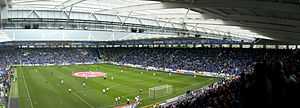
Professional and semi professional sports teams include: Leicester Tigers (rugby union), Leicester City (football), Leicester Riders (basketball), Leicester Lions (speedway), and the Leicestershire County Cricket Club.
Sports clubs include: Leicester Coritanian A.C. (athletics) and Leicester Penguins Swimming Club who were awarded Sports Club of the Year by the Leicester Mercury at their annual sports awards for 2007 and 2008.
Leicester Racecourse is located to the south of the city in Oadby.
After a period of success for the football, cricket and rugby teams around the turn of the millennium, Leicester was for some time dubbed (by the local press and local inhabitants at least) the sporting capital of the UK, and a statue commemorating this period was erected in the town centre.
Leicester Tigers on Welford Road are one of the most successful Rugby Union teams in Europe, having won the European cup twice, the first tier of English rugby ten times, and the Anglo-Welsh cup seven times. Notable former players include England's Rugby World Cup winning captain Martin Johnson, Neil Back, Dean Richards and Austin Healey.
Leicester City have also enjoyed a fair degree of success. They have championed the second tier of the English league system on a record seven occasions, competed in the top flight regularly during their history, won three Football League Cups and reached the FA Cup Final four times although they have never won the trophy. In the 2008–09 season they competed in and won League One (third tier), to which they were relegated for the first time. In 2014, they returned to the Premier League after 10 years away. Their current stadium is the King Power Stadium (formerly the Walkers Stadium), situated south of the city centre and near to the site of Filbert Street from which they relocated in 2002 after 111 years. Notable former managers include Jimmy Bloomfield, David Pleat, Brian Little, and Martin O'Neill. Notable former players include Gordon Banks (England's World Cup winning goalkeeper in 1966), Peter Shilton, Frank Worthington, Gary Lineker (the second highest goalscorer of all time for the England team with 48 goals between 1984 and 1992), Alan Smith, Emile Heskey, Neil Lennon, Simon Grayson and Matt Elliott.
Motorcycle speedway racing has been staged in Leicester on and off since 1928. In the pioneer days speedway was staged at a track known as Leicester Super situated in Melton Road and at 'The Stadium' in Blackbird Road. Post war, the Leicester Hunters joined the National League Division Three in 1949 and operated at various levels until closure at the end of 1962. The sport was revived for a spell from 1968 before the sale and subsequent redevelopment of the site ended the first Leicester Lions era in 1983. Planning permission was granted in October 2009 for a brand-new speedway track at Beaumont Park, with Leicester Lions returning to action in the Premier League from 2011 to 2013. In 2014 the Leicester Lions will race in the Elite League.
Leicester is also home to the Leicester Falcons, an American football team that competes as part of the BAFA National Leagues and in 2011 was promoted to the BAFA Premier League, the highest tier of British American Football. The Falcons' home ground is located at Babington Community College, in the Beaumont Leys area of the city.
Leicester Phoenix are a rugby league club based in the centre of the city. The club was founded in 1986. After playing in different British Amateur Rugby League Association leagues (namely the Midlands and South West Amateur Rugby League and the East Midlands Amateur Rugby League) the Phoenix were one of the 10 founder members of the Rugby League Conference (then the Southern Conference League) in 1997 reaching the grand final in the inaugural season. Since then they have been one of the league's most consistent performers. Their 1st Grade Team currently compete in the Midlands Premier division of the Rugby League Conference.
Leicester Rowing Club is a rowing and sculling club based in the centre of the city on the River Soar. Formed in 1882 they represent Leicester in Regatta and Head Races around Great Britain and Worldwide. The club insignia is based on the mythical Wyvern and rowers compete in the club's colours of black and white.[98]
The city also hosted British and World track cycling and Road Racing championships at its Saffron Lane velodrome in August 1970. The cycle track was improved specially for the event which was televised all over the world. Another first meant that sponsors were allowed to buy sections of the track to utilise for advertising purposes. This was also the first time that a public road – the A46 – was closed in the UK to allow the Road Race to take place:- See The Benny Foster Story published by Fretwell 1971. However, this was the second world championships to be hosted by the city, in 1883 the first ever Bicycling World Championships were held at the Belgrave Road Grounds.
In 1989 and 2009, the city hosted the British Special Olympics. This was the adopted charity for the Lord Mayor of Leicester 2008–2009,Councillor Manjula Sood.[99]
Until its demolition in 1999, Granby Halls was a popular live music, exhibition and sports arena in the city. It was also notable as the long serving home of professional basketball team, the Leicester Riders, from 1980 until 1999.
The Dolly Rockit Rollers roller derby league are based in Leicester. They were ranked amongst the top eight UKRDA members for 2011, and played at the Association's 2012 championship tournament as a result.
Leicester Hockey Club are based at Leicester Grammar School in Great Glen.
Leicester Tornadoes Korfball Club[100] who compete in the East Midlands Korfball league are based at De Montfort University's Queen Elizabeth II Diamond Jubilee Leisure Centre.
Leicester was also the '2008 European City of Sport'.[101]
Public services
In the public sector, University Hospitals Leicester NHS Trust is one of the larger employers in the city, with over 12,000 employees working for the Trust. Leicester City Primary Care Trust employs over 1,000 full and part-time staff providing healthcare services in the city. Leicestershire Partnership NHS Trust employs 3,000 staff providing mental health and learning disability services in the city and county.
In the private sector are Nuffield Hospital Leicester and the Spire Hospital Leicester.
Notable people
Local media
Leicester is home to the Leicester Mercury newspaper, and the Midlands Asian Television channel known as MATV Channel 6.
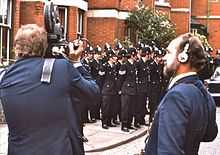
BBC Radio Leicester was the first BBC Local Radio station in Britain, opening on 8 November 1967. Other analogue FM radio stations are Demon FM which is Leicester's community & student radio station broadcasting from Demontfort University, Takeover Radio is the first ever children's radio station in the UK to be produced and presented by children, Capital FM East Midlands Gem 106, 106.6 Smooth Radio and Hindu Sanskar Radio, which only broadcasts during Hindu religious festivals. BBC Asian Network and Sabras Radio broadcast on AM.
The local DAB multiplex has the following stations:
- Capital FM East Midlands
- BBC Radio Leicester
- Sabras Radio
- Highways Agency Traffic Radio
- XFM
- Classic Gold GEM
- Gem 106
- Asian Plus – also known as Hindu Sanskar Radio
- Takeover Radio
- Smooth Radio
There are two hospital radio stations in Leicester, Radio Fox and Radio Gwendolen. The first children's radio station, Takeover Radio, broadcasts in Leicester.
Twin cities
Leicester is twinned with six cities.[102]
|
Since 1973, the fire services of Leicester and twin city Krefeld have played each other in an annual 'friendly' football match.[105]
References
- Notes
- ↑ "Population on 1 January by age groups and sex - larger urban zone". Retrieved 19 September 2014.
- ↑ 2.0 2.1 "2011 Census: Ethnic group, local authorities in England and Wales". ONS. Retrieved 12 December 2012.
- ↑ "2011 Census - Built-up areas". ONS. Retrieved 8 September 2013.
- ↑ "The 10 ages of Leicester buildings: Roman to 2000s". BBC news Leicester. 28 January 2011. Retrieved 4 May 2013.
- ↑ "Leicester shortlisted for UK City of Culture 2017 title". 20 November 2013. Retrieved 20 November 2013.
- ↑ "Hull named UK City of Culture 2017". 20 November 2013. Retrieved 20 November 2013.
- ↑ Thompson (1849), Appendix B: Leograceaster—The Saxon Name of Leicester, pp. 448 f.
- ↑ Thompson (1849), pp. 7 f.
- ↑ Saxon Chronicle
- ↑ 10.0 10.1 Nennius (attrib.). Theodor Mommsen (ed.). Historia Brittonum, VI. Composed after AD 830. (Latin) Hosted at Latin Wikisource.
- ↑ 11.0 11.1 Ford, David Nash. "The 28 Cities of Britain" at Britannia. 2000.
- ↑ Allen, Grant. "Casters and Chesters" in The Cornhill Magazine, Vol. XLV, pp. 419 ff. Smith, Elder, & Co. (London), 1882.
- ↑ Encountered, for example, in Geoffrey of Monmouth's History of the Kings of Britain, which calls the town Kaerleir.[14]
- ↑ 14.0 14.1 Galfridus Monemutensis [Geoffrey of Monmouth]. Historia Regum Britanniæ. c. 1136. (Latin) J.A. Giles & al. (trans.) as History of the Kings of Britain, Vol. II, Ch. 11 in Six Old English Chronicles. 1842. Hosted at Wikisource.
- ↑ Leicester is on the River Soar and Legro or Leire could have been the name of the tributary at Leire. "Legorensis civitas" (803) and "Ligera ceaster" (917) are the earliest forms; William of Malmesbury says Leicester is named "a Legra fluvio" (from the river Legra). Ekwall, E. (1940) The Concise Oxford Dictionary of English Place-names; 2nd ed. Oxford: Clarendon Press; p. 280
- ↑ Stevenson, W.H. "A note on the derivation of the name 'Leicester'" in The Archaeological Journal, Vol. 75, pp. 30 f. Royal Archaeological Institute (London), 1918, pp. 30–31.
- ↑ Ekwall, Eilert. English River-names, p. xlii. Clarendon Press (Oxford), 1928.
- ↑ Jackson, Kenneth. Language and History in Early Britain, p. 459. (Edinburgh), 1953.
- ↑ Thompson, James. The History of Leicester, from the Time of the Romans to the End of the Seventeenth Century, p. 2. J. S. Crossley (Leicester), 1849.
- ↑ Kelly, William. Royal Progresses and Visits to Leicester: From the Reputed Foundation of the City by King Leir, B.C. 844, to the Present Time, §I, p. 10. Sam'l Clarke (Leicester), 1884.
- ↑ Haverfield, Francis. Roman Leicester, p. 31. Hunt, Barnard, & Co. (Leicester), 1918.
- ↑ 22.0 22.1 Thompson (1849), Appendix A: Ratæ—Roman Leicester, pp. 443 ff.
- ↑ Tomlin, R S O (1983). "Roman Leicester, a Corrigendum: For Coritani should we read Corieltauvi?". Transactions of the Leicester Archaeological and Historical Society 48.
- ↑ Tomlin, R S O (1983). "Non Coritani sed Corieltauvi". The Antiquaries Journal 63.
- ↑ 25.0 25.1 "Richard III team makes second Leicester car park find". BBC news Leicester. 4 May 2013. Retrieved 4 May 2013.
- ↑ Wright, Neil (1984). The Historia Regum Britannie of Geoffrey of Monmouth. Woodbridge, England: Boydell and Brewer. pp. xvii–xviii. ISBN 978-0-85991-641-7.
- ↑ "...the Historia does not bear scrutiny as an authentic history and no scholar today would regard it as such.": Wright (1984: xxviii)
- ↑ Geoffrey of Monmouth. Lewis Thorpe (trans.) as The History of the Kings of Britain, pp. 81 & 86. Harmondsworth, 1966.
- ↑ e.g., Williamson, David (1998). The National Portrait Gallery History of the Kings and Queens of England. National Portrait Gallery Publications. p. 81.
- ↑ "Richard III dig: Have they found their man in Leicester?".
- ↑ Lawless, Jill (4 February 2013). "Richard III team confirms skeleton found under parking lot is remains of England's king". The Star.j
- ↑ "Official Website of the British Monarchy – Jane".
- ↑ "1645:The Storming of Leicester and the Battle of Naseby".
- ↑ "Chartism in Leicestershire". A Web of English History. Dr Marjie Bloy.
- ↑ William, David (13 October 2010). UK Cities: A Look at Life and Major Cities in England, Scotland, Wales and Northern Ireland. New Africa Press. p. 127. ISBN 9987160212.
- ↑
- ↑ Leicester's Ugandan Asian success story. Retrieved 28 November 2010.
- ↑ A history of Leicester. Retrieved 28 November 2010.
- ↑ "From Kampala to Leicester". Leicester City Council. Retrieved 7 April 2013.
- ↑ Lowther, Ed (30 January 2013). "Government warned not to repeat 'folly' of Uganda anti-immigration adverts". BBC. Retrieved 7 April 2013.
- ↑ "Leicester City Council to thank Indian immigrants". Immigration Matters. 10 September 2012. Retrieved 7 April 2013.
- ↑ Huttman, Elizabeth D.; editor,; Blauw, Wim; co-editors, Juliet Saltman, (1991). Urban housing segregation of minorities in Western Europe and the United States. Durham: Duke University Press. ISBN 978-0822310600.
- ↑ 43.0 43.1 "Ugandan Asians advert 'foolish', says Leicester councillor". BBC. 8 August 2012. Retrieved 7 April 2013.
- ↑ Marett, Valerie (1989). Immigrants settling in the city. Leicester: Leicester University Press. ISBN 978-0718512835.
- ↑ Equality and Human Rights Commission – home page
- ↑ Research (The University of Manchester)
- ↑ "Equality and Human Rights Commission – home page".
- ↑ "August 1990 Maximum". Retrieved 26 February 2011.
- ↑ "August 2003 Maximum". Archived from the original on 19 August 2003. Retrieved 23 February 2012.
- ↑ "1971-00 Average annual maximum". Retrieved 26 February 2011.
- ↑ "Max > 25 °C days". Retrieved 26 February 2011.
- ↑ "Jan 1963 Minimum". Retrieved 26 February 2011.
- ↑ "1971-00 average rainfall". Retrieved 26 February 2011.
- ↑ "1971-00 average raindays". Retrieved 23 February 2011.
- ↑ "Climate Normals and extremes". KNMI. July 2011. Retrieved 26 February 2011.
- ↑
- ↑ Agnes Johnson Glimpses of ancient Leicester – Page 60 1891 "The first Mayor of Leicester, A.D. 1251.
- ↑ The history of the boroughs and municipal corporations of the ... – Page 229 Henry Alworth Merewether, Archibald John Stephens – 1835 "The mayor of Leicester and his brethren, having, with the consent of the commonalty, by the last ordinance, placed the town under the government of the aldermen, appear, in the 4th year of the reign of King Henry VII., to have adopted 1488. a ..."
- ↑ What participation by foreign residents in public life at local ... – Page 91 Congress of Local and Regional Authorities of Europe – 2000 "In 1981 serious riots broke out in the city that were dubbed "race riots" in Highfields and the City centre. ... In 1987 the first Asian Mayor of Leicester was elected, Councillor Gordhan Parmar and the first Asian Member of Parliament, Keith Vaz
- ↑ BBC Leicester's elected mayor reports lord mayor over parking August 2011
- ↑ United Kingdom Census 2001 (2001). "Leicester (Local Authority)". neighbourhood.statistics.gov.uk. Retrieved 28 December 2007.
- ↑ 62.0 62.1 "Leicester profile of 2001 census". Office for National Statistics. 2003. Retrieved 28 December 2007.
- ↑ "Mid-year estimates for 2006" (XLS). Office for National Statistics. 2007. Retrieved 28 December 2007.
- ↑ "Leicester population density". Statistics.gov.uk. Retrieved 28 December 2007.
- ↑ "Leicester key statistics". Statistics.gov.uk. Retrieved 28 December 2007.
- ↑ "Leicester country of birth data". Statistics.gov.uk. Retrieved 28 December 2007.
- ↑ "2011 Census: Religion, local authorities in England and Wales". United Kingdom Census 2011. Office for National Statistics. Retrieved 12 December 2012.
- ↑ http://www.leicestermercury.co.uk/fast-growing-city-needs-backing-Government/story-16589527-detail/story.html
- ↑ "The Diversity of Leicester May 2008, A Demographic Profile". Leicester City Council. Archived from the original on 8 January 2009. Retrieved 16 November 2008.
- ↑ http://www.prospectleicestershire.co.uk/why-here
- ↑ http://www.uk.cat.com/cda/layout?m=65333&x=7
- ↑ "Leicester in spotlight for textiles boost". Leicester Mercury. 11 January 2011. Retrieved 14 January 2013.
- ↑ "Far Eastern costs boost textile firm". Leicester Mercury. 15 September 2010. Retrieved 14 January 2013.
- ↑ Panesar, Jeevan (13 October 2006); "Diwali in Leicester, BBC, Accessed 25 January 2011.
- ↑ Walkers Crisps, Coming to the crunch – The Manufacturer, October 2006
- ↑ http://www.pepsico.co.uk/our-company/contact-us/our-offices-factories-and-sites
- ↑ Our company – Samworth Brothers, October 2007
- ↑ Mack, Tom (15 December 2012); "Temporary pop-up Walkers pork pie shop to open in Cheapside, Leicester, for Christmas, Leicester Mercury, Accessed 17 December 2012.
- ↑ Components may not sum to totals due to rounding
- ↑ includes hunting and forestry
- ↑ includes energy and construction
- ↑ includes financial intermediation services indirectly measured
- ↑ "Leicester 360° Images – 360-degree tour of Shree Jalaram Prathana Mandal". BBC. Retrieved 17 July 2010.
- ↑ "Leicester 360° Images – 360-degree tour of Jain Centre". BBC. Retrieved 17 July 2010.
- ↑ http://www.islamiccentre.org/
- ↑ http://www.masjid-umar.org/
- ↑ "Leicester – In Pictures – Masjid Umar mosque". BBC. Retrieved 17 July 2010.
- ↑ "Plans for £150m station facelift". BBC News. 6 March 2008.
- ↑ Schools building deal is signed and sealed – Leicester Mercury, 19 December 2007
- ↑ "Curve website".
- ↑ "Student flats plan to replace The Charlotte music venue in Leicester". http://www.leicestermercury.co.uk''. Leicester Mercury. Retrieved 10 January 2015.
- ↑ talking history:the newsletter of the East Midlands Oral History Archive. Number 7: May 2003.
- ↑ "The Displacements - Track Reviews - NME.COM".
- ↑ "Kyte Announce New 2008 Tour Dates".
- ↑ http://summersundae.com/about-us
- ↑ http://www.noquartergiven.co.uk/leicester-handmade-festival-2013-day-one-2/
- ↑ http://robwatsonmedia.net/handmade-festival-leicester-2013-day-three/
- ↑ "Leicester Rowing Club at British Rowing". Britishrowing.org. Retrieved 17 July 2010.
- ↑ "City to host its second 'games'". BBC News. 13 July 2007. Retrieved 14 July 2007.
- ↑ "Leicester Korfball". http://leicesterkorfball.org.uk/''. Leicester Tornadoes Korfball Club. Retrieved 10 January 2015.
- ↑ "Leicester City Council – European City of Sport 2008". Leicester.gov.uk. Archived from the original on 7 May 2008. Retrieved 17 July 2010.
- ↑ "Twinning". Leicester City council. Retrieved 5 February 2010.
- ↑ "Strasbourg, Twin City". Strasbourg.eu & Communauté Urbaine. Archived from the original on 28 July 2013. Retrieved 21 August 2013.
- ↑ "British towns twinned with French towns [via WaybackMachine.com]". Archant Community Media Ltd. Archived from the original on 5 July 2013. Retrieved 20 July 2013.
- ↑ Brown, Tom (31 July 2013). "Twin towns: Do we still need them?". BBC East Midlands Today (BBC News). Retrieved 7 August 2013.
- Further reading
- Hoskins, W. G. (1957) Leicestershire: an illustrated essay on the history of the landscape. London: Hodder & Stoughton
External links
| Wikimedia Commons has media related to Leicester. |
- "Leicester Tourist Guide".
- "One Leicester".
- "Leicester City Council".
- "My Leicestershire History".
- "Leicester & Leicestershire Guide".
| ||||||||||
| ||||||||||||||||||||||
| ||||||||||||||||||||||||||||
| ||||||||||||||||
